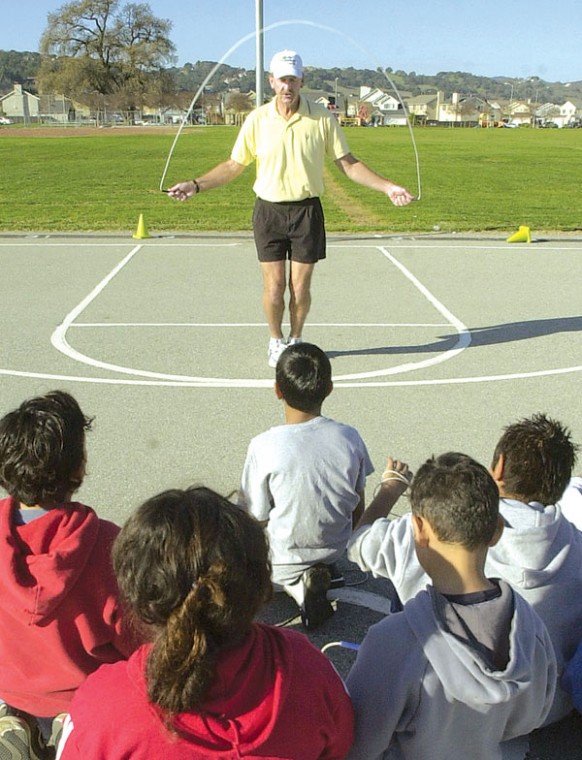GILROY
– Elementary school children in Gilroy continue to get roughly
70 minutes a week less than what the state requires for physical
education instruction. And despite an effort by the Gilroy Unified
School District to reform its physical education program, local
P.E. and regular teachers do not see mu
ch hope for turning things around.
GILROY – Elementary school children in Gilroy continue to get roughly 70 minutes a week less than what the state requires for physical education instruction. And despite an effort by the Gilroy Unified School District to reform its physical education program, local P.E. and regular teachers do not see much hope for turning things around.
“Sometimes, you think maybe the days of a comprehensive education are over,” said Pat Midtgaard, principal of Antonio Del Buono School. “In some European models, schools are focused only on academics. Anything beyond that is picked up by community programs in sports, music, art, etcetera.”
A loggerhead between GUSD and its physical education teachers erupted last spring when the Gilroy Teachers Association filed a grievance and, at one point, refused to administer a state physical education test. They claimed administering the test to students who have not received adequate physical instruction was unfair and unsafe.
GUSD formally denied the grievance in June, claiming that the requirement for conducting the required P.E. tests “does not violate the district’s policy of providing fair, accurate, objective and age-appropriate instruction.”
Nonetheless, GUSD formed a special committee this school year to develop a model for increasing the amount of time teachers can get their students physically active.
“Frankly, physical education has been on the back burner the last few years since other priorities related to improving literacy and math have taken over,” Superintendent Edwin Diaz said. “But we’ve formed a committee, and recommendations are being developed for an appropriate (P.E.) curriculum.”
The special committee, made up of district-wide physical education teachers and administrators, is due to present its ideas to the school board Feb. 13. But even if the board likes what it hears, implementing policies for improving physical education could take several months.
There could be some specific recommendations by February, but the committee’s target date for recommendations is March 13, when it will make a presentation to the GUSD educational services department, said Sal Tomasello, the South Valley Middle School principal who heads the group.
Complicating matters is that, in order to cut costs, the GUSD trimmed P.E. class time several years ago, but promised to make up the required time by having classroom teachers involve students in physical activities during the academic day.
“The district has never lived up to that part of the bargain,” says Pat Vickroy, a P.E. teacher at four elementary schools in GUSD who has led the local charge to improve student health. “We’re at the point we may need to bring in an outside mediator to settle this.”
Midtgaard, a physical education major and a former high school P.E. teacher, is an advocate for student health. In these days of higher accountability and increased mandates to improve test scores, teachers are hard-pressed to find time for their students to be physically active, Midtgaard says.
Based on state recommendations for time spent on literacy and math, Midtgaard said teachers at fourth- through sixth-grade are left with 80 minutes to cover science and social studies.
“And that doesn’t even take into account time to manage a class, collect homework or take role,” Midtgaard said.
It also doesn’t take into account the 200 minutes of physical education every five days required by the state.
Although the state mandates the P.E. minutes, it does not set up any repercussion when instruction levels are not met, Vickroy said.
Increased support from the school board – as well as recent studies on childhood obesity and the correlation between increased physical activity and higher academic scores – is bolstering Vickroy’s efforts.
In December, the state Department of Education released study results indicating that higher achievement was associated with higher levels of fitness at multiple grade levels. The study also showed that students who met minimum fitness levels in three or more physical fitness areas showed the greatest gains in academic achievement.
Fewer than 20 percent of GUSD students have met state standards for fitness in recent years, Vickroy said. In academics, roughly half of GUSD students are considered by the state to be “at grade level.”
The GUSD’s goal is for 90 percent of its students to be at grade level – in the 50th percentile on nationally-referenced standardized tests – by 2004. Vickroy said he hopes a physical education program can be devised that allows teachers to combine academic instruction with outdoor physical activities, such as practicing long-distance running while learning about how the heart works in science.
“Right now, there’s just a tad too much testing going on,” GUSD Trustee John Gurich said. “Kids need an outlet, especially at the elementary school level, and we need to find ways to give that to them.”
Gurich, a physical education department head at a high school in Morgan Hill, advocated for concerned P.E. teachers in recent months, more than once pressing for a time the special committee would report to the board.
“You know the old saying, ‘strong body, strong mind,'” Gurich said. “What’s scary is the studies that are showing this generation of kids will die younger. What good is it to know how to read if you’re not alive to get the book?”














